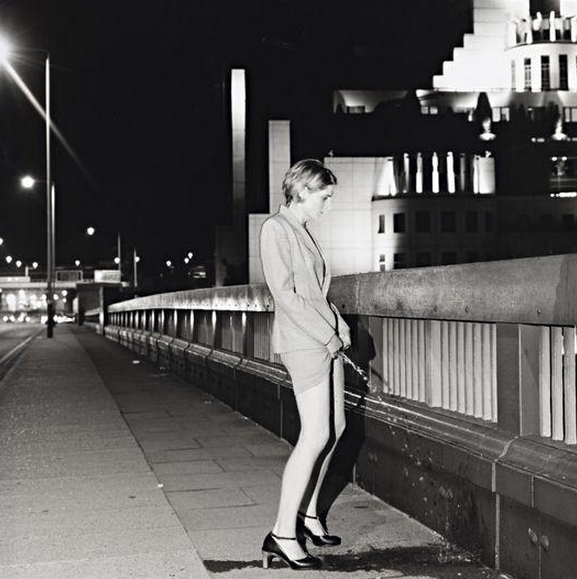Pissing Women
Sophy Rickett
Essay
Originally published Summer 2012
Edited Summer 2020.

©The artist, Sophy Rickett.
Pissing Women, by British visual artist Sophy Rickett, is one that not only remains the black sheep of an otherwise conventional lineage of works, but one that to this day still stands tall as an unmatched feat of raw, orchestrated and somewhat contemplative performance art. The series, created in 1995 and completely with black and white film at night, opened a dialogue on phallic fetishisation, its historically assumed power and its place within societal order. With Ricketts dressed formally in a range of suits, and actively selecting locations synonymous with order (i.e. Vauxhall Bridge, with MI-5 headquarters in the background, or the marble facade of what can be assumed to be an office in Central London), it becomes easy at face value to see the images as rebellious, or at least created to challenge a patriarchal society. However, when the images themselves are deconstructed, and things such as the deliberate harsh flash used from the camera, the inviting and consistent side angle positioning of the camera and more interestingly the unseen effort gone through to make the urination as masculine as possible (one can only assume that it must have taken a few tries with it being public), the images seem to be more of a bold parody of masculinity than a mere, rebellious angsty disdain for it. With urination (especially public urination) being seen so typically as an act whose core radiates rebellion, we may excuse ourselves for falling into the trap of seeing it no more than a physical act of frustration or angst.
Another subtle, yet interesting element within the series is the fact that each image depicts a different character caught during the same act. Rickett sports a range of outfits and hairstyles, in order to portray a range of women from a similar demographic, for reasons that remain unclear, to the extent of making one wonder; were these characters created as a personal and political interpretation of observed scenes? Were they a collective, albeit artificial sneer at acceptability and gender norms on the topic of decency and decorum, or an attack on social class even? All of these questions however, must not distract audiences from the power she has sought simply from urinating whilst standing. To crouch, stoop or bend in order to urinate, is to submit to a basic biological need to do so and a logistical need to do so successfully. Here, this is waived; the halo of the phallus is removed, with the member itself, chanllenged and almost mocked, reduced to little more than a myth. There is little doubt that the phallus can be replicated, imitated and made a caricature of, as many other patriarchal aspects that remain within contemporary society and sexuality. Ricketts can brazenly urinate, in public, without stooping or exposing her genitals and yet, challenges this all without actively disguising herself as a man, or going through any effort to conceal or distort her gender as part of the performance. She is a woman, visually dissecting an act of men, in typically male-dominated surroundings and she wants to be seen; she wants to be observed for what she is and what she is doing.
Although Pissing Women served as a landmark series in both social and societal gender-orientated commentary (and one of many that explored female urination as an act of rebellion) it’s bittersweet that few of Rickett’s work explored similar subversive themes and approaches. It is clear that this tangent still had life in it yet. Still, over twenty years on this infamous, somewhat enigmatic series remains relevant and will remain so, for as long as men, and to some extent, patriarchal society remain in awe of the hole from which they piss.